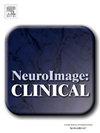Hypothalamic atrophy and structural covariance in amnestic mild cognitive impairment and Alzheimer’s dementia
IF 3.6
2区 医学
Q2 NEUROIMAGING
引用次数: 0
Abstract
Background
Alzheimer’s disease (AD) is characterized by progressive cognitive decline and specific brain atrophy patterns, primarily involving the medial temporal lobes. A number of studies have discussed hypothalamic involvement in AD with consecutive metabolic and/or autonomic disturbances yet only few studies have investigated hypothalamic atrophy in AD and its early stages in particular. Methods: We applied semi-automated volumetry of the hypothalamus (HTH) in 3 T MRI in a sample N = 175 participants [age 74.9 ± 7.22; gender 85 m/90f; cognitively normal controls (CN; N = 56); amnestic mild cognitive impairment (MCI; N = 78); AD (N = 41)] from the Alzheimer’s Disease Neuroimaging Initiative (ADNI). In addition, we used voxel-based morphometry (VBM), cortical thickness (CTH) analyses and source-based morphometry (SBM) derived networks of structural covariance to investigate brain structural covariance patterns of the HTH under consideration of diagnostic groups, β-amyloid (AB) positivity and apolipoprotein E (APOE) ε4 status. Results: Hypothalamic atrophy was observed in both early and advanced disease stages (i.e. hypothalamic volume CN > MCI > AD). VBM, CTH analysis and SBM revealed positive associations between hypothalamic volume (HV) and AD-vulnerable regions, largely corresponding to the Papez circuit and brain regions implicated in autonomic regulation, however, group differences regarding HTH structural covariance were not observed. Similar observations were made in carriers and non-carriers of the ε4 allele, yet more pronounced in ε4 carriers. Although not reaching significance, comparisons of AB positive vs. negative subjects indicated stronger HTH atrophy in biomarker positive participants. HV was not associated with body mass index or longitudinal weight change. Conclusions: Our findings support early structural changes of the HTH in AD. HV covaries with regional volumes of AD-vulnerable regions. This could point to secondary atrophy of the HTH following atrophy of the hippocampus and other structures of the Papez circuit in AD.
失忆性轻度认知障碍和阿尔茨海默氏症痴呆症的下丘脑萎缩和结构协方差
背景阿尔茨海默病(AD)的特征是进行性认知能力下降和特定的脑萎缩模式,主要涉及内侧颞叶。许多研究讨论了下丘脑参与伴有新陈代谢和/或自律神经紊乱的阿兹海默症,但只有少数研究调查了阿兹海默症及其早期阶段的下丘脑萎缩。方法:我们对阿尔茨海默病神经影像学倡议(ADNI)的175名参与者[年龄74.9 ± 7.22;性别85 m/90f;认知正常对照组(CN;N = 56);失忆性轻度认知障碍(MCI;N = 78);AD(N = 41)]进行了3 T MRI下丘脑(HTH)半自动容积测量。此外,我们还使用体素形态计量学(VBM)、皮质厚度(CTH)分析和基于源形态计量学(SBM)的结构协方差网络,研究了诊断组别、β-淀粉样蛋白(AB)阳性和脂蛋白E(APOE)ε4状态下HTH的脑结构协方差模式。结果在疾病的早期和晚期均可观察到下丘脑萎缩(即下丘脑体积 CN > MCI > AD)。VBM、CTH分析和SBM揭示了下丘脑体积(HV)与AD易感区之间的正相关,主要对应于Papez回路和与自主神经调节有关的脑区,但没有观察到HTH结构协方差的组间差异。在ε4等位基因携带者和非携带者中也发现了类似的现象,但在ε4等位基因携带者中更为明显。对 AB 阳性和阴性受试者的比较表明,生物标志物阳性受试者的 HTH 萎缩程度更强,但未达到显著性水平。HV与体重指数或纵向体重变化无关。结论:我们的研究结果支持AD患者HTH的早期结构变化。HV与AD易感区的区域体积相关。这可能表明,在AD患者的海马和Papez回路的其他结构发生萎缩后,HTH也会发生继发性萎缩。
本文章由计算机程序翻译,如有差异,请以英文原文为准。
求助全文
约1分钟内获得全文
求助全文
来源期刊

Neuroimage-Clinical
NEUROIMAGING-
CiteScore
7.50
自引率
4.80%
发文量
368
审稿时长
52 days
期刊介绍:
NeuroImage: Clinical, a journal of diseases, disorders and syndromes involving the Nervous System, provides a vehicle for communicating important advances in the study of abnormal structure-function relationships of the human nervous system based on imaging.
The focus of NeuroImage: Clinical is on defining changes to the brain associated with primary neurologic and psychiatric diseases and disorders of the nervous system as well as behavioral syndromes and developmental conditions. The main criterion for judging papers is the extent of scientific advancement in the understanding of the pathophysiologic mechanisms of diseases and disorders, in identification of functional models that link clinical signs and symptoms with brain function and in the creation of image based tools applicable to a broad range of clinical needs including diagnosis, monitoring and tracking of illness, predicting therapeutic response and development of new treatments. Papers dealing with structure and function in animal models will also be considered if they reveal mechanisms that can be readily translated to human conditions.
 求助内容:
求助内容: 应助结果提醒方式:
应助结果提醒方式:


